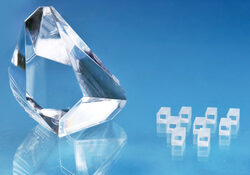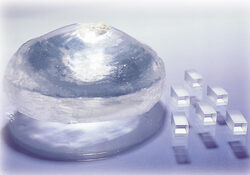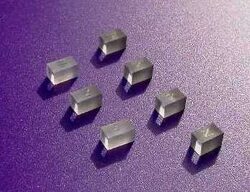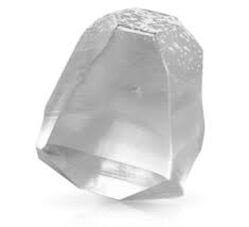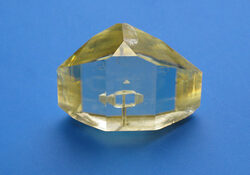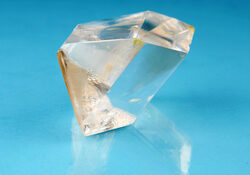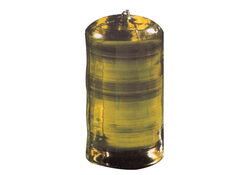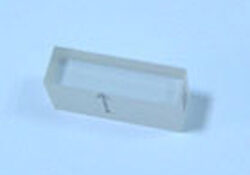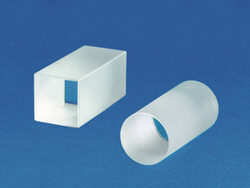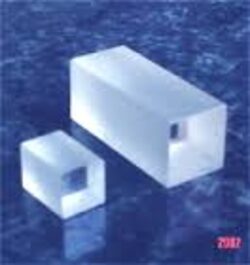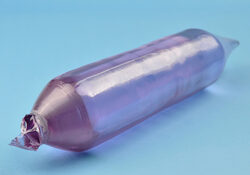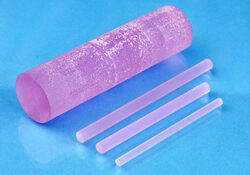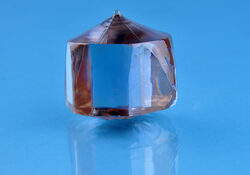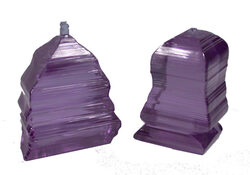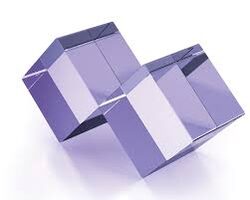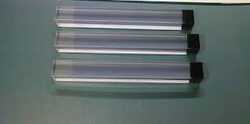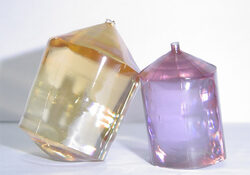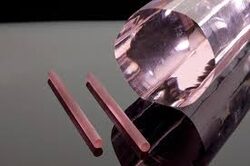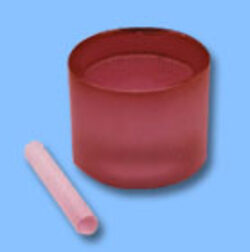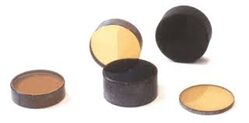Nonlinear Crystals
Lithium Triborate (LBO) Crystal
- Broad transparency range from 160nm to 2600nm
- High optical homogeneity (dn»10-6/cm) and being free of inclusion
- Relatively large effective SHG coefficient (about three times that of KDP)
- High damage threshold
- Wide acceptance angle and small walk-off
- Type I and Type II non-critical phase matching (NCPM) in a wide wavelength range
- Spectral NCPM near 1300nm
Beta-Barium Borate (BBO) Crystal
- Broad phase matchable range from 409.6nm to 3500nm
- Wide transmission region from 190 nm to 3500nm
- Large effective second-harmonic-generation (SHG) coefficient about 6 times greater than that of KDP crystal
- High damage threshold
- High optical homogeneity with dn »10-6/cm
- Wide temperature-bandwidth of about 55°C
Potassium Titanyl Phosphate (KTP) Crystal
- Large nonlinear optical coefficient
- Wide angular bandwidth and small walk-off angle
- Broad temperature and spectral bandwidth
- High electro-optic coefficient and low dielectric constant
- Large figure of merit
- Nonhydroscopic, chemically and mechanically stable
Rubidium Titanyle Phosphate (RTP) Crystal
- Higher damage threshold (about 1.8 times of KTP), high resistivity
- High repetition rate, no hygroscopic and no induce piezo-electric effect with electrical signals up to 60 kHz
- Transmission range is 350nm to 4500nm
Potassium Titanyle Arsenate (KTA) Crystal
- Crystal length from 0.1mm to 30mm and size up to 15 x 15 x 30mm
- AR-coating from visible to 3300nm
- Re-polishing, re-coating service
Bounded-Input, Bounded-Output (BiBO) Crystal
- Large crystal size up to 10x10x15mm3
- AR-coating,mounts and repolishing services
Lithium Niobate (LiNbO3) Crystal
- Used as frequency doublers for wavelength >1μm and OPOs pumped at 1064nm and quasi-phase-matched (QPM) devices
- Most commonly used material for Pockel Cells Q-switches and phase nodulators, waveguide substrate, and surface acoustic wave (SAW) wafers, etc.
Magnesium Doped Lithium Niobate (MgO:LiNbO3) Crystal
- High damage threshold
- Noncritical phase matching(NCPM)at room temperature
- Broad transparency range
- Excellent E-O and NLO properties
- Good mechanical and chemical properties
Potassium Dihydrogen Phosphate (KDP) & Potassium Dideuterium Phosphate (DKDP or KD*P) Crystal
- Good UV transmission, High damage threshold, High birefringence
- Used for doubling, tripling and quadrupling of a Nd:YAG laser at the room temperature
Lithium Iodate (LiIO3) Crystal
- Used for frequency-doubling, -tripling and mixing of low and medium power lasers
- Provides large size of LiIO3 Crystals with high optical homogeneity
Laser Crystals
Neodymium Doped Yttrium Aluminum Garnet (Nd:YAG ) Crystal
- Earliest and most famous laser host crystal
- Since it combines great advantages in many basic properties, Nd:YAG is the ubiquitous presence for near-infrared solid-state lasers and their frequency-doubler, tripler, and higher order multiplier
Neodymium Yttrium Lithium Fluoride (Nd:YLF) Crystal
- Grows using Czochralski method
- Use of high quality starting materials for crystal growth
Neodymium Doped Yttrium Orthovanadate (Nd:YVO4) Crystal
- Most efficient laser host crystal for diode pumping low to middle power density
- An ideal laser tool that can cover the most widespread applications of lasers including machining, material processing, spectroscopy, wafer inspection, light displays, medical diagnostics, laser printing, and data storage, etc.
Neodymium doped Potassium-Gadolinium Tungstate (Nd:KGW) Crystal
- An excellent laser gain material which has low laser oscillations threshold and higher emission section
- Higher doping concentration of active ion
Ytterbium doped Potassium-Gadolinium Tungstate crystals (Yb:KGW) Crystal
- An excellent laser gain material which has important advantages over the widely used Nd3+ doped materials
- Allows the generation of short (ps or fs) laser pulses
Diffusion Bonded Crystals
- Consist of one laser crystal and one or two undoped material.
- Combined by optical contact method and further bonded under high temperature
- Helps to decrease thermal lensing effect considerably
Neodymium Doped Gadolinium Orthovanadate(Nd:GdVO4) Crystal
- Large stimulated emission cross section at laser wavelength
- High absorption coefficient and wide bandwidth at pump wavelength
- Low dependency on pump wavelength
- Good thermal conductivity
- Low lasing threshold and high slope efficiency
- High laser induced damage threshold
- Strongly-polarized laser output.
Erbium-Doped Yttrium Aluminum Garnet (Er:YAG) Crystal
- An excellent laser crystal which lases at 2.94μm
- Used in medical applications, such as dental (hard tissues), orthopedics, etc.
Titanium Doped Sapphire (Ti:Sapphire) Crystal
- Used for widely tunable and ultrashort pulsed lasers with high gain and high power outputs
- Growth method of Temperature Gradient Technique (TGT)
Chromium Doped Yttrium AIuminum Garnet (Cr4+:YAG) Crystal
- An excellent crystal for passively Q-switching diode pumped or lamp-pumped Nd:YAG, Nd:YLF, Nd:YVO4 or other Nd and Yb doped lasers at wavelength from 0.8 to 1.2µm
- Chemically stable, durable, UV resistant, good thermal conductivity and high damage threshold (> 500 MW/cm2) and being easy to be operated
